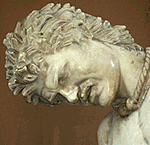Literary Sources
I. List of Sources
As discussed in the section on Celtic ethnic and cultural identity, the surviving ancient
sources on the "Celts," both Greek and Latin, were written well after
the late Hallstatt and early La Tène periods discussed here.
The authors all come from cultural backgrounds very different from
that of the "Celts." Each has his own reasons for writing about the
"Celts," none of which includes leaving an accurate and objective
ethnographic description for the use of modern historians. Studies of
the ancient "Celts" cannot but refer to the classical sources, since
there is no early Celtic literature preserved at all; their temporal,
geographic and cultural distance from their subject, as well as the
exigencies of their respective genres, suggest we exercise due
caution in applying their observations to the earlier period.
The following list indicates the general periods during with the
authors were writing, and translations used.
|
5th century BCE:
|
Herodotos, Histories, (various)
|
|
2nd century BCE:
|
Polybius, Rise of the Roman Empire, (trans. W.R.
Paton)
|
|
135-50 BCE:
|
Poseidonios, Histories, (quoted in Athenaeus)
|
|
early 1st century BCE:
|
Diodoros Siculus, The Library of History, (trans.
C. H. Oldfather)
|
|
1st century BCE:
|
Caesar, The Gallic War, (trans. C. Hammond)
|
|
64 BCE - ca. AD 23:
|
Strabo, Geography, (trans. H.L. Jones)
|
|
59 BCE - AD 17:
|
Livy, History of Rome from its Foundation,
(trans.A. de Sélincourt)
|
|
AD 98:
|
Tacitus, Germania, (trans. H. Mattingly, S.A.
Handford rev.)
|
|
1st - early 2nd century AD:
|
Plutarch, Life of Camillus, (trans. J. Dryden)
|
|
ca. AD 200:
|
Athenaus, Deipnosophistai, IV.151 ff., (trans.
C.B. Gulick)
|
II. Discussions
Useful to the student of "Celtic"-Mediterranean interactions are
numerous studies of individual authors, among them
Tierney (1960) and
Alonso-Núñez (1994) on
Poseidonios, or Walbank's 1970 commentary on Polybius.
Dirkzwager presents an extremely detailed
study of Gallia Narbonensis in Strabo, while Burkert is informative about Herodotos and the
beliefs of the barbarians of his time. Ancient thought about the
barbarian "other" and the nature of civilization are the objects of a
great deal of attention; approaching them from very different points
of view are, e.g., Blundell (1986) on ancient models of
civilization, Müller (1972) on ancient ethnography and
Nippel (1990) on barbarians in ancient society
and law. Dihle (1994) takes a historical approach to
the changing relationships of the Greeks to the barbarians within
their ken. Essential are Momigliano's studies of ancient
historiography, the Greeks and the barbarians.
while Burkert is informative about Herodotos and the
beliefs of the barbarians of his time. Ancient thought about the
barbarian "other" and the nature of civilization are the objects of a
great deal of attention; approaching them from very different points
of view are, e.g., Blundell (1986) on ancient models of
civilization, Müller (1972) on ancient ethnography and
Nippel (1990) on barbarians in ancient society
and law. Dihle (1994) takes a historical approach to
the changing relationships of the Greeks to the barbarians within
their ken. Essential are Momigliano's studies of ancient
historiography, the Greeks and the barbarians.
The ancient authors are invoked by every general history or survey
of "Celtic" history, society or art. Specific studies analyzing the
sources and their historical implications in Celtic studies include
Hachmann (1962) on Celtic identity,
Nachtergael (1977) on the "Celts" at Delphi;
Rankin (1987) and
Cunliffe (1988) on the "Celts" from the
classical perspective; and Freeman's 1994 dissertation on early classical
sources and Celtic beliefs.
The wealth of material -- ancient sources and modern commentary --
while gratifying, serves also to highlight the great void at the
center of all our investigations, the lack of literature by the
ancient "Celts" themselves.
 Home
Home
 while Burkert is informative about Herodotos and the
beliefs of the barbarians of his time. Ancient thought about the
barbarian "other" and the nature of civilization are the objects of a
great deal of attention; approaching them from very different points
of view are, e.g., Blundell (1986) on ancient models of
civilization, Müller (1972) on ancient ethnography and
Nippel (1990) on barbarians in ancient society
and law. Dihle (1994) takes a historical approach to
the changing relationships of the Greeks to the barbarians within
their ken. Essential are Momigliano's studies of ancient
historiography, the Greeks and the barbarians.
while Burkert is informative about Herodotos and the
beliefs of the barbarians of his time. Ancient thought about the
barbarian "other" and the nature of civilization are the objects of a
great deal of attention; approaching them from very different points
of view are, e.g., Blundell (1986) on ancient models of
civilization, Müller (1972) on ancient ethnography and
Nippel (1990) on barbarians in ancient society
and law. Dihle (1994) takes a historical approach to
the changing relationships of the Greeks to the barbarians within
their ken. Essential are Momigliano's studies of ancient
historiography, the Greeks and the barbarians.